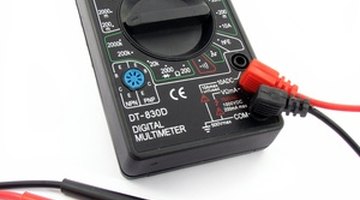How to Tell if a 12-Volt Solar Panel Is Charging
Solar photovoltaic (PV) panels generate direct-current (DC) electricity that can be used to charge a battery. A battery charge controller is used to ensure that the battery is not over-charged. Most charge controllers will indicate electricity coming from the solar panel as well as the level of the current charging the battery. If a battery is connected directly to a solar panel, however, other ways are necessary to show electricity being supplied to the battery.

-
Buy a small device to measure DC voltage. Look for a digital multimeter at a local supplier or online. It should cost less than $20. The meter will have two test probes: one red and one black.
-
Measure the voltage at the output of the solar panel. Turn on the multimeter and turn the dial until it measures DC voltage. Place the red probe on the positive terminal of the panel and the black probe on the negative terminal. If there is sunshine directly on the front of the solar panel, the meter should show a voltage between 10 and 17 volts. If the multimeter shows no voltage, check carefully each connection on the back of the solar panel.
-
Measure the voltage at the point where the wires from the solar panel are connected to the battery. Disconnect the wires from the battery and measure the difference in voltage between the two wires using the probes on the multimeter. The voltage should be just a little less than what you measured on the solar panel. If the multimeter measures no voltage, check along the wires to make sure there is no break in the connection.
-
With the wires from the solar panel still disconnected, measure the voltage of the battery. Write down the voltage in volts. Reconnect the wires and let the solar panel charge the battery during the day. At the end of the day, measure the voltage again. You should see that the voltage of the battery has increased, indicating that it is being charged.
Tips
- If you don't have a multimeter, check that electricity is reaching the battery by simply disconnecting the wires from the battery and touching them briefly together to see if you get a spark (this type of short circuit does not damage the solar panel). But if you want to check that the solar panel is producing the proper voltage, you will need a multimeter.
Writer Bio
Peter Johnson has managed development programs in Africa and the Caribbean since 1985. Focusing on community management of natural resources, renewable energy and sustainable economic development, he has worked in Djibouti, Sudan, Egypt, Mali, Madagascar, Guinea and most recently in Haiti. He has postgraduate degrees in chemical engineering and fuel technology, as well as protected landscape management.
Photo Credits
- multimeter image by dinostock from Fotolia.com
More Articles



